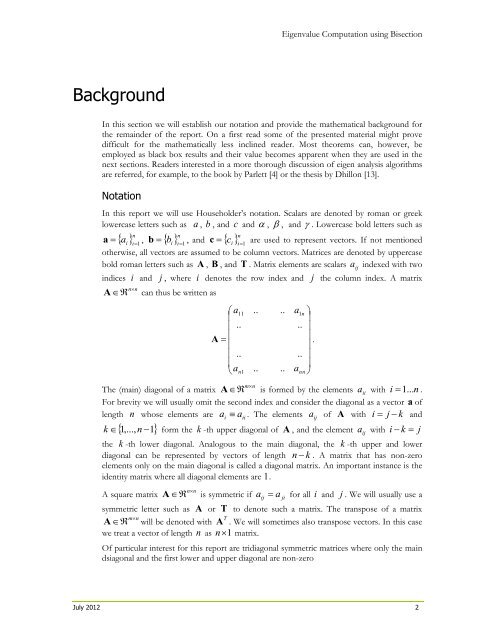Christian Lessig
SORtc
SORtc
- No tags were found...
Create successful ePaper yourself
Turn your PDF publications into a flip-book with our unique Google optimized e-Paper software.
Eigenvalue Computation using Bisection<br />
Background<br />
In this section we will establish our notation and provide the mathematical background for<br />
the remainder of the report. On a first read some of the presented material might prove<br />
difficult for the mathematically less inclined reader. Most theorems can, however, be<br />
employed as black box results and their value becomes apparent when they are used in the<br />
next sections. Readers interested in a more thorough discussion of eigen analysis algorithms<br />
are referred, for example, to the book by Parlett [4] or the thesis by Dhillon [13].<br />
Notation<br />
In this report we will use Householder’s notation. Scalars are denoted by roman or greek<br />
lowercase letters such as a , b , and c and , , and . Lowercase bold letters such as<br />
a a n i<br />
, b b n i1<br />
i<br />
, and n i1<br />
i i<br />
c c are used to represent vectors. If not mentioned<br />
1<br />
otherwise, all vectors are assumed to be column vectors. Matrices are denoted by uppercase<br />
bold roman letters such as A , B , and T . Matrix elements are scalars a<br />
ij<br />
indexed with two<br />
indices i and j , where i denotes the row index and j the column index. A matrix<br />
nn<br />
A can thus be written as<br />
a11<br />
.. .. a1<br />
n <br />
<br />
<br />
..<br />
.. <br />
A <br />
.<br />
<br />
<br />
..<br />
.. <br />
<br />
<br />
an1<br />
.. .. ann<br />
<br />
mn<br />
The (main) diagonal of a matrix A is formed by the elements a<br />
ii<br />
with i 1...<br />
n .<br />
For brevity we will usually omit the second index and consider the diagonal as a vector a of<br />
length n whose elements are ai<br />
aii<br />
. The elements a<br />
ij<br />
of A with i j k and<br />
k 1 ,..., n 1<br />
form the k -th upper diagonal of A , and the element a<br />
ij<br />
with i k j<br />
the k -th lower diagonal. Analogous to the main diagonal, the k -th upper and lower<br />
diagonal can be represented by vectors of length n k . A matrix that has non-zero<br />
elements only on the main diagonal is called a diagonal matrix. An important instance is the<br />
identity matrix where all diagonal elements are 1.<br />
A square matrix<br />
nn<br />
A is symmetric if<br />
ij ji<br />
a a for all i and j . We will usually use a<br />
symmetric letter such as A or T to denote such a matrix. The transpose of a matrix<br />
mn<br />
T<br />
A<br />
will be denoted with A . We will sometimes also transpose vectors. In this case<br />
we treat a vector of length n as n 1<br />
matrix.<br />
Of particular interest for this report are tridiagonal symmetric matrices where only the main<br />
dsiagonal and the first lower and upper diagonal are non-zero<br />
July 2012 2


